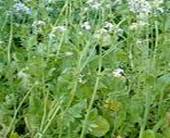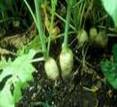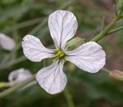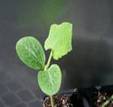| Kingdom | Plantae |
| Class | Magnoliopsida |
| Order | Capparales |
| Family | Brassicaceae |
| Genus | Raphanus |
| Species | R. sativus |
| Binomial name | Raphanus sativus |
Other Common Names:
The other common names for radish are ridiche, radish, redish, bier radish and daikon.
History
The name of this familiar garden plant is suggested by its colour, being derived from the Saxon, rude, rudo, or reod (ruddy), or from the Sanskrit rudhira,meaning blood. Radish (Raphanus sativus) gets its English name, as well as similar names in French and Italian, from radix, the Latin word for "root,'' especially a radish root. The technical name of the genus, Raphanus, is a Latinized form of an old Greek expression raphanos, freely translated as "easily reared" an apt name.

Description
This introduced annual or biennial plant consists of a rosette of leaves; somewhat later, it bolts and produces flowering stems up to 2½' tall. The basal leaves are up to 7" long and 2½" across; they are oblanceolate, coarsely crenate, and pinnately lobed. These lobes may be shallow or deep; the terminal lobe is always the largest. The surface of the basal leaves is usually rough from stiff hairs. The central stem is often reddish at the base, but light green elsewhere; it is either glabrous or covered with scattered stiff hairs. The upper side stems are very similar, except that there is often a red ring where they branch from the central stem.



Each flower is replaced by a silique that contains 2-3 seeds. This silique is rather short and spongy, but it has a long beak. There is very little constriction between the seeds, if any. The seeds are oval-shaped, slightly flattened, and reddish brown. The root system consists of a stout taproot that is somewhat fleshy. It is often reddish, but other colour forms occur. This plant spreads by reseeding itself.
Range
Its distributed throughout China especially the Mediterranean region and now cultivated worldwide. The Egyptians were cultivating radishes 3000 years before Christ. The radish reached China by 500 BC. Today the radish is the most widely grown vegetable in Japan.
Habitat
Radish is generally seen in dumps, edges of gardens, areas along roadsides and railroads, and waste areas. Radishes will grow best in full sun, but they will still grow in semi-shade.
Cultivation
One of the fastest and easiest to grow vegetables, radishes can thrive in almost any climate. Some varieties grow so fast that they can be harvested as little as three weeks after the seeds are planted. Actually, the trick with radishes is not leaving them in the ground too long, or you can end up with woody, bitter tasting radishes. The great thing about radishes is that they can be grown year round; however, many varieties do best in cool weather. To maintain a continuous crop, you want to sow your radishes every two or three weeks. Another great thing about radishes is that you can plant them in the shadier spots of your garden where other vegetables will not grow. You want to plant your radish seed about 1/4-inch deep and at least 2 inches from one another. Within one to two weeks, seedling should begin to appear. It is important to keep the soil moist during this growing period. You might consider using a liquid fertilizer once a week. Seeds are sown in outdoors in situ in succession from late winter to the middle of summer. Germination takes place within a few days of sowing the seed. If you want a constant supply of the roots then you need to sow seed every 2 - 3 weeks.
Parts Used

Root, seed-pods and the tuber of radish are the most commonly used parts for its commercial and medicinal purposes.
Flowering Season
The flowers are hermaphrodite and are in bloom from June to August.
Pests and Diseases
The main pests that affect radishes are white butterflies and cabbage moths. Use a soap shield or Bt to prevent this. Small pests include aphids, mealy bugs and scale insects, some caterpillars, sawfly larvae and of course slugs and snails. Large pests include rabbits, mice, birds and deer.
Medicinal Applications


• The roots stimulate the appetite and digestion, having a tonic and laxative effect upon the intestines and indirectly stimulating the flow of bile.
• Consuming radish generally results in improved digestion, but some people are sensitive to its acridity and robust action.
• The plant is used in the treatment of intestinal parasites, though the part of the plant used is not specified.
• The leaves, seeds and old roots are used in the treatment of asthma and other chest complaints.
• The juice of the fresh leaves is diuretic and laxative. The seed is carminative, diuretic, expectorant, laxative and stomachic.
• It is taken internally in the treatment of indigestion, abdominal bloating, wind, acid regurgitation, diarrhoea and bronchitis.
• The root is ant scorbutic, antispasmodic, astringent, cholagogue, digestive and diuretic.
• It is crushed and used as a poultice for burns, bruises and smelly feet.
• Radishes are also an excellent food remedy for stone, gravel and scorbutic conditions.
• Its use is not recommended if the stomach or intestines are inflamed.
• The plant also shows anti-tumour activity.
Commercial Applications


• It is also useful for repelling various other insect pests such as carrot root fly.
• A spicy flavour with a crisp pleasant texture, they make a nice addition to salads or can be used as a broccoli substitute.
• There is a fodder variety that grows more vigorously and is used as a green manure.
• An edible oil is obtained from the seed.
• Crisp and juicy, they have a hot and spicy flavour and are a very popular addition to salads.

Citizens of Oaxaca, Mexico celebrate the radish in a festival called Noche de los Rábanos (Radish Night) on December 23rd as a part of Christmas celebrations. Locals carve religious and popular figures out of radishes and display them in the town square. There used to be a competition held in olden days where apples were suspended by string from doorways or ceilings, at a height that allowed them to be caught between the teeth.
With their hands at their sides, the first person to successfully take a bite from an apple received a prize. In tradition, these prizes would consist of cushions of silk in the representation of tomatoes, radishes, apples, pears, pickles; or pen-wipers representing brooms, cats, witches, or other objects that signified this time of year. Parents of Japan take a more freewheeling approach, often starting babies on heartier, more flavourful fare like radishes.